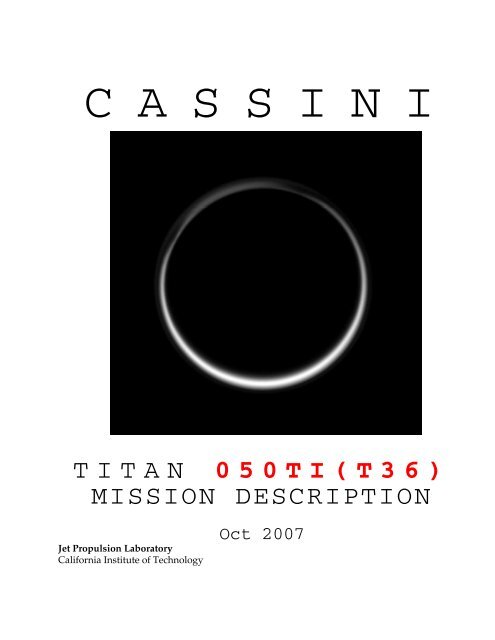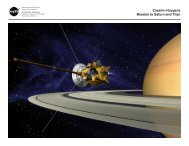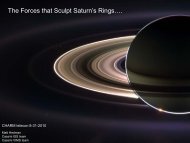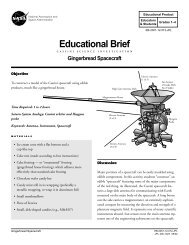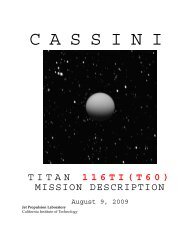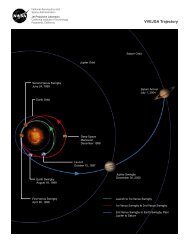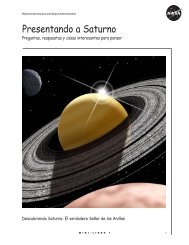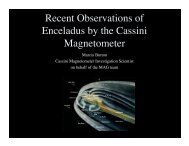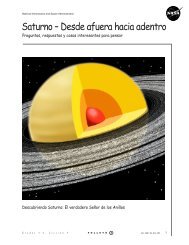Mission Description - Cassini - NASA
Mission Description - Cassini - NASA
Mission Description - Cassini - NASA
Create successful ePaper yourself
Turn your PDF publications into a flip-book with our unique Google optimized e-Paper software.
CASSINITITAN 050TI(T36)MISSION DESCRIPTIONJet Propulsion LaboratoryCalifornia Institute of TechnologyOct 2007
Cover image: Ring of Twilight August 16, 2007. This celestial circle of light is produced by the glowof sunlight scattered through the periphery of Titan's atmosphere as the Sun is occulted by Titan. It isthe sum of all the sunsets and sunrises taking place on Titan at once. The intriguing structure ofTitan's north polar "hood" can be seen at upper left. A thin, detached, high-altitude global haze layerencircles the moon. North on Titan (5,150 kilometers, 3,200 miles across) is up and rotated 23 degreesto the left. The image was taken in visible blue light with the <strong>Cassini</strong> spacecraft wide-angle camera onJune 29, 2007. The view was obtained at a distance of approximately 210,000 kilometers (131,000 miles)from Titan and at a Sun-Titan-spacecraft, or phase, angle of 167 degrees. Image scale is 12 kilometers (8miles) per pixel. Credit: <strong>NASA</strong>/JPL/Space Science Institute1.0 OVERVIEWThirty-two days after <strong>Cassini</strong>’s Titan-35 flyby, the spacecraft revisits Titan for its thirty-seventhtargeted encounter. The closest approach to Titan occurs on Tuesday, October 2, at 2007-275T04:42:43 spacecraft time at an altitude of 975 kilometers (~605 miles) above the surface andat a speed of 6.3 kilometers per second (14,000 mph). The latitude at closest approach is 60degrees S and the encounter occurs on orbit number 50.This encounter is set up with two maneuvers: an Iapetus encounter cleanup maneuver onSeptember 17, and a Titan approach maneuver, scheduled for September 28. T36 is the secondin a series of outbound encounters that will last until the end of the prime mission, and occursless than two days after Saturn closest approach. This is the first in a series of seven Titansouthern hemisphere encounters.2
ABOUT TITANIf Titan were a planet, it would likely stand out as the most important planet in the solarsystem for humans to explore. Titan, the size of a terrestrial planet, has a denseatmosphere of nitrogen and methane and a surface covered with organic material. It isTitan that is arguably Earth’s sister world and the <strong>Cassini</strong>-Huygens mission considersTitan among its highest priorities.Although it is far colder and lacks liquid water, the chemical composition of Titan’satmosphere resembles that of early Earth. This, along with the organic chemistry thattakes place in Titan’s atmosphere, prompts scientists to believe that Titan could providea laboratory for seeking insight into the origins of life on Earth. Data from the Huygensprobe, which touched down on Titan’s surface in January 2005, and the <strong>Cassini</strong> orbiterhas shown that many of the processes that occur on Earth also apparently take place onTitan – wind, rain, volcanism, tectonic activity, as well as river channels, and drainagepatterns all seem to contribute in shaping Titan’s surface. However, at an inhospitable-290 degrees Fahrenheit (-179 degrees Celsius), the chemistry that drives these processesis fundamentally different from Earth’s. For example it is methane that performs manyof the same functions on Titan that water does on Earth.The Huygens probe landed near a bright region now called Adiri, and photographedlight hills with dark riverbeds that empty into a dark plain. It was believed that thisdark plain could be a lake or at least a muddy material, but it is now known thatHuygens landed in the dark region, and it is solid. Scientists believe it only rainsoccasionally on Titan, but the rains are extremely fierce when they come.Only a small number of impact craters have been discovered. This suggests that Titan’ssurface is constantly being resurfaced by a fluid mixture of water and possiblyammonia, believed to be expelled from volcanoes and hot springs. Some surfacefeatures, such as lobate flows, appear to be volcanic structures. Volcanism is nowbelieved to be a significant source of methane in Titan’s atmosphere. However, there areno oceans of hydrocarbons as previously hypothesized. Dunes cover large areas of thesurface.The existence of oceans or lakes of liquid methane on Saturn's moon Titan waspredicted more than 20 years ago. Radar and imaging data from Titan flybys haveprovided convincing evidence for large bodies of liquid. With Titan's coldertemperatures and hydrocarbon-rich atmosphere, these lakes and seas most likelycontain a combination of liquid methane and ethane (both hydrocarbons), not water.4
The <strong>Cassini</strong>-Huygens mission, using wavelengths ranging from ultraviolet to radio, ismethodically and consistently revealing Titan and answering long-held questionsregarding Titan’s interior, surface, atmosphere, and the complex interaction withSaturn’s magnetosphere. While many pieces of the puzzle are yet to be found, with eachTitan flyby comes a new data set that furthers our understanding of this world as weattempt to constrain scenarios for the formation and evolution of Titan and itsatmosphere.1.1 TITAN-36 SCIENCE HIGHLIGHTS• RADAR is looking forward to an opportunity to examine Titan's southern regions. TheT36 flyby will reach similar latitudes to the southernmost previous RADARobservations, on T7. RADAR observations include inbound and outbound radiometryof terrain at low and mid latitudes; inbound and outbound scatterometry of Titan,including views of the Huygens landing site, inbound and outbound altimetry, and ashort segment of high-altitude, low resolution SAR around 30 deg South.• INMS allows RADAR to control the spacecraft pointing during closest approach, butRADAR is actually “riding along” while INMS takes observations close to Titan inorder to determine atmospheric and ionospheric composition and thermal structure.These observations are part of the MAPS Titan campaign.• UVIS makes several slow scans across Titan's visible hemisphere to form spectralimages. The objective is to obtain spectral images of Titan in the EUV and FUV to mapthe aurora and dayglow, to map hydrocarbon absorption, and to measure scatteringand absorption by aerosols in the stratopshere. The UVIS slit will be scanned acrossTitan's disk to build up an image at many wavelengths.• VIMS will capture global maps of Titan to study cloud evolution and seek otherchanges.• ISS will monitor Titan via limited global-scale mosaics for surface and atmospherechanges. The imaging team will attempt to see surface color variations, and monitorlimb hazes. Similar areas were covered at higher resolution during the T35 flyby. ISShad coverage of similar areas at higher resolution during the T35 flyby;. series of flybysthat cover the same area repeatedly are useful for monitoring time dependentphenomena. These observations will allow us to see if, for instance, clouds areappearing or disappearing, if there are patterns in weather, or if the weather has anycorrelations with Titan surface features.• MAG did receive successfully downlinked data from the T7 flyby, and will therefore beable to use data from the T36 flyby to look for temporal variations in the magnetic fieldin the wake/south polar region.5
1.2 SAMPLE SNAPSHOTSThree views of Titan from <strong>Cassini</strong> before, during, and after closest approach to Titan areshown below. The views are oriented such that the direction towards the top of the page isaligned with the Titan North Pole. The optical remote sensing instruments’ fields of vieware shown assuming they are pointed towards the center of Titan. The sizes of these fieldsof view vary as a function of the distance between <strong>Cassini</strong> and Titan. A key for use inidentifying the remote sensing instruments fields of view in the figures is listed at the topof the next page.6
Key to ORS Instrument Fields of View in FiguresInstrument Field of ViewDepiction in FigureISS WAC (imaging wide angle camera)Largest squareVIMS (visual and infrared mapping spectrometer) Next largest pink squareISS NAC (imaging narrow angle camera)Smallest green squareCIRS (composite infrared spectrometer) – Focal Plane 1 Small red circle near ISS_NAC FOVUVIS (ultraviolet imaging spectrometer)Vertical purple rectangle centeredwithin largest squareView of Titan from <strong>Cassini</strong> two hours before Titan-36 closest approach7
View of Titan from <strong>Cassini</strong> at Titan-36 closest approach8
View of Titan from <strong>Cassini</strong> two hours after Titan-36 closest approach9
Titan Groundtracks for T36: Global Plot10
Titan Groundtracks for T36: Polar Plot11
The T36 timeline is as follows:Colors: yellow = maneuvers; blue = geometry; pink = T36-<strong>Cassini</strong> Titan-36 Timeline - October 2007related; green = data playbacksOrbiter UTC Ground UTC Pacific Time Time wrt T35 Activity <strong>Description</strong>265T20:51:00 Sep 22 22:14 Sat Sep 22 02:14 PM T36-09d08h Start of Sequence S34 Start of Sequence which contains Titan-36271T11:36:00 Sep 28 12:59 Fri Sep 28 04:59 AM T36-03d17h OTM #130 Prime Titan-36 targeting maneuver.272T04:06:00 Sep 29 05:29 Fri Sep 28 09:29 PM T36-03d01h OTM #130 Backup273T11:28:40Sep 30 12:51 Sun Sep 30 04:51 AM T36-01d17h Saturn PeriapseSaturn periapse, R = 4.7 Rs, lat = 5 deg, phase = 138deg274T22:49:40 Oct 02 00:12 Mon Oct 01 04:12 PM T36-05h53m Descending Ring Plane Crossing274T12:51:00 Oct 01 14:14 Mon Oct 01 06:14 AM T36-15h51m Start of the TOST segment274T12:51:00 Oct 01 14:14 Mon Oct 01 06:14 AM T36-15h51m Turn cameras to Titan274T13:21:00 Oct 01 14:44 Mon Oct 01 06:44 AM T36-15h21m Deadtime9 minutes 43 seconds long; used to accommodate changesin flyby time274T13:30:43Obtain information on CO, HCN, CH4. Integrate on diskOct 01 14:53 Mon Oct 01 06:53 AM T36-15h12m Titan atmospheric Observationsat airmass 1.5--2.0.274T18:42:43Photometry observations of particle properties,Oct 01 20:05 Mon Oct 01 12:05 PM T36-10h00m Titan atmospheric observationsvertical distributions ~6 km/px.274T19:42:43Oct 01 21:05 Mon Oct 01 01:05 PM T36-09h00m Titan atmospheric Observations EUVFUV imaging of Titan274T23:31:43 Oct 02 00:54 Mon Oct 01 04:54 PM T36-05h11m New Waypoint274T23:53:43Oct 02 01:16 Mon Oct 01 05:16 PM T36-04h49m RADAR Observations Radiometry275T02:42:43Oct 02 04:05 Mon Oct 01 08:05 PM T36-02h00m RADAR Observations Scatterometry275T03:50:43 Oct 02 05:13 Mon Oct 01 09:13 PM T36-00h52m Transition to thruster control275T04:11:56Oct 02 05:34 Mon Oct 01 09:34 PM T36-00h31m RADAR Observations Altimetry275T04:27:43Oct 02 05:50 Mon Oct 01 09:50 PM T36-00h15m INMS/RADAR Observations SAR observations275T04:42:43Altitude = 975 km (605 miles), speed = 6.3 km/s (14,000Oct 02 06:05 Mon Oct 01 10:05 PM T36+00h00m Titan-36 Flyby Closest Approach Timemph); 67 deg phase at closest approach275T15:09:14 Oct 02 16:32 Tue Oct 02 08:32 AM T36+10h27m Ascending Ring Plane Crossing275T04:57:43Oct 02 06:20 Mon Oct 01 10:20 PM T36+00h15m RADAR Observations Altimetry275T05:12:43 Oct 02 06:35 Mon Oct 01 10:35 PM T36+00h30m Transition off of thruster control275T05:36:01Oct 02 06:59 Mon Oct 01 10:59 PM T36+00h54m RADAR Observations Scatterometry275T06:42:43Oct 02 08:05 Tue Oct 02 12:05 AM T36+02h00m RADAR Observations Radiometry275T09:32:43 Oct 02 10:55 Tue Oct 02 02:55 AM T36+04h50m New Waypoint275T09:52:43 Oct 02 11:15 Tue Oct 02 03:15 AM T36+05h10m Titan surface observations Regional Map275T12:42:43Oct 02 14:05 Tue Oct 02 06:05 AM T36+08h00m Titan surface observations Global Map275T13:22:43Oct 02 14:45 Tue Oct 02 06:45 AM T36+08h40m Titan atmospheric ObservationsPhotometry observations275T13:42:43Obtain information on CO, HCN, CH4. Integrate on diskOct 02 15:05 Tue Oct 02 07:05 AM T36+09h00m Titan atmospheric Observationsat airmass 1.5--2.0.275T15:42:43Titan surface and atmosphereOct 02 17:05 Tue Oct 02 09:05 AM T36+11h00mobservationsISS NAC monitoring of surface and atmosphere275T17:42:43Oct 02 19:05 Tue Oct 02 11:05 AM T36+13h00m Titan surface observations Regional Map275T18:42:43Obtain information on the thermal structure of Titan'sOct 02 20:05 Tue Oct 02 12:05 PM T36+14h00m Titan atmospheric observationsstratosphere.276T03:28:43 Oct 03 04:51 Tue Oct 02 08:51 PM T36+22h46m Deadtime22 minutes 17 seconds long; used to accommodatechanges in flyby time276T03:51:00 Oct 03 05:14 Tue Oct 02 09:14 PM T36+23h09m Turn to Earth-line276T04:19:00 Oct 03 05:42 Tue Oct 02 09:42 PM T36+23h37m Playback of T36 Data Madrid 70 and 34MThe T36 playback timelines is as follows (following page):12


